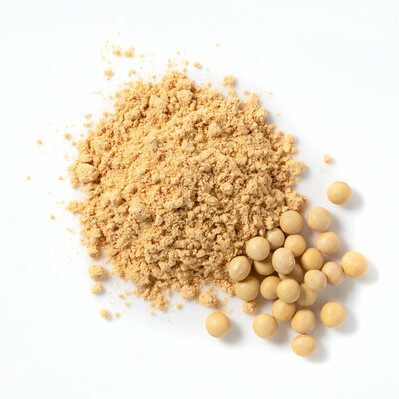Soya Flour
Also known as Soybean Flour and Soy Flour
What is Soya Flour?
Soya flour is a fine powder obtained from grinding roasted soybeans. When added to baked goods, soya flour can improve their nutritional value, mainly increasing their protein content, and enhancing texture via lipid oxidation. 1
Soybean flour is commercially available in several varities: 1,2
- Enzyme -active soy flour
- Enzyme-inactive soy flour
- Defatted soybean flour (less than 1% soybean oil)
- Full fat soy flour (18 – 20% soybean oil)
- Low fat soy flour (4.5 – 9 % soybean oil)
- High fat soy flour (15% soybean oil)
Origin
Soya (Glycine max) is an ancient pulse crop. Its origin can be traced to 7000 BCE China, where it was first domesticated. The earliest known definition of soybean flour was in 1880.
Commercial use of soybean flour started in the 1930s in the UK.2 Today, soybean is considered a major oilseed and its flour is used in a variety of baked products.
Function
Soya flour has several functions in baked goods:1,3
- Nutritional value: improves protein content.
- Crumb whitener: via oxidation of carotenoids present in wheat flour.
- Water holding capacity improver
- Gas retention: by releasing bound lipids, proteins become more hydrophilic and can enhance dough’s viscoelasticity.
- Egg and nonfat dry milk replacer.
One challenge with soya flour is the potential undesirable taste when used above typical levels (1-2%) of the flour weight. 1
Nutrition
Typical nutritional value of soya flour per 100 g:4
| Component | Value |
|---|---|
| Carbohydrate | 50.7 |
| Fat | 25.4 |
| Water | 14.04 |
| Protein | 9.86 |
Soya flour provides 565 kcal per 100g.4
Commercial production
Soya flour is commercially produced through the following process:3
- Drying: harvested and stored soybeans are dried down to a moisture content of 10% using vertical gas forced circulation dryers.
- Tempering: soybeans are left for 2-5 day in storing tanks to equilibrate moisture content.
- Cleaning: soybeans are passed through magnetic separators to remove metals. Stalks and foreign materials are removed using seed cleaners.
- Classification: whole and split beans are separated with a classic sifting operation.
- Cracking: soybeans are cracked using counter- rotating rolls, and different sized portions are separated.
- Humid heating: dehulled soybean meat is subjected to humid heat to reach the required Nitrogen Solubility Index (NSI) using vertical conditioners with direct and indirect steam heating, followed by cooling.
- Grinding: cooled dehulled soybeans are ground to flour using hammer mills or pin mills.
- Packaging
Application
Soya flour is used in gluten-free baking or as a replacement for nonfat dry milk. Its typical usage level and impact on baked goods are shown in the following table:1,3
| Ingredient |
Usage level (flour weight basis) |
Effect on baked goods |
|---|---|---|
| Egg Replacement | 1 Tablespoon of soy flour with 1 tablespoon of water to replace 1 egg |
|
| Wheat Flour | < 2% |
|
| Wheat Flour | 2-5% |
|
| Wheat Flour | > 10% |
|
| Non Fat Milk Solids | 1.5-2% |
|
Regulations
Soya flour is considered GRAS by the FDA when following good manufacturing practices.5
In the EU, soya flour is regulated by several EU Commission Regulations due to GMO issues.6
References
- Cauvain, Stanley P., and Young, L.S. “Technology of breadmaking.” (2007): 285-286.
- Shurtleff, W and Aoyagi, A. History of soy flour, grits and flakes (510 CE to 2013): extensively annotated bibliography and sourcebook. Soyinfo Center, 2013.
- Berk, Z. Technology of production of edible flours and protein products from soybeans. 1992.
- U.S. Department of Agriculture, Agricultural Research Service. FoodData Central, 29 July 2021. https://fdc.nal.usda.gov/fdc-app.html#/food-details/1871219/nutrients . Accessed 15 November 2021.
- Food and Drug Administration (FDA). US Department of Health and Human Services. CFR Code of Federal Regulations Title 21, Part 101 Food Labeling, https://www.accessdata.fda.gov/scripts/cdrh/cfdocs/cfcfr/CFRSearch.cfm?fr=101.82 , Accessed 20 November 2021.
- Yves Bertheau, J.D. Soybean in the European Union, status and perspective. Recent trends for enhancing the diversity and quality of soybean products, InTech – Open Access Publisher, 2011, 978-953-307-533-4. 10.5772/18896 . hal-02810708


